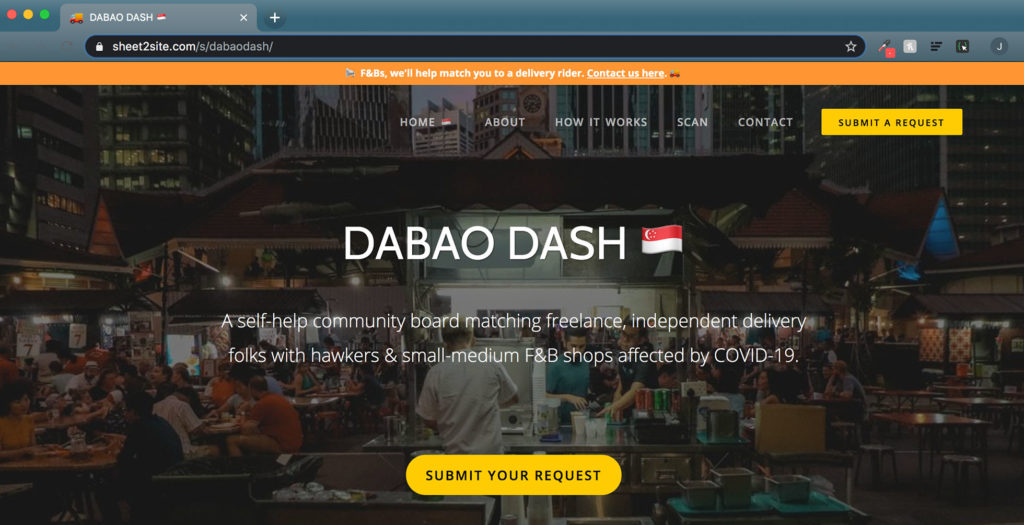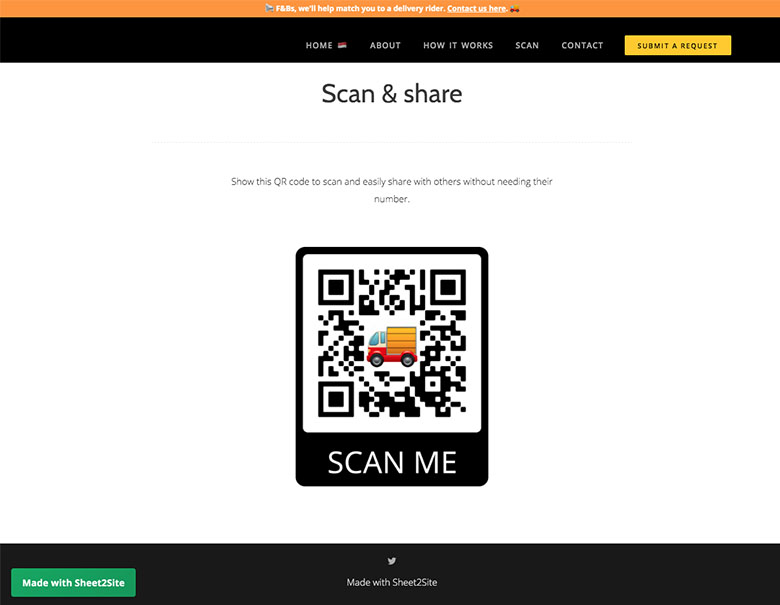
Design Challenge
#3: How might we learn from COVID-19 to reimagine our future for life, work, learning and play?
Project Description
Dabao Dash is a self-help community board matching freelance, independent delivery folks with hawkers and small-medium F&B shops affected by COVID-19. Hawkers can request for delivery, and riders can offer delivery services. This non-profit, ‘B2B’ website aims to help hawkers and small F&Bs pivot to delivery-only business model, without expensive middleman fees that cut into their already slim margins. An early minimum viable product is already live at https://bit.ly/dabaodash
Criteria #1: Value
With Circuit Breaker measures like cessation of dine-in, our local small F&Bs and hawkers are now struggling to stay afloat, many even closing down for good. Many need to supplement with or completely switch to a delivery-only business model, but don’t know where to find food delivery drivers in their own. Typical hawker margins are slim – only ~15%, so using middleman food delivery apps with >30% commission won’t work for them. Many hawkers and small F&B owners might not be tech savvy enough to onboard to these platforms either. On the other side, delivery riders could now serve a larger pool of vendors, expanding their income sources. Customers as well will benefit from more food choices, from the hawkers they know and love, and saving the food heritage of Singapore.
Criteria #2: Inspiration
The spark of inspiration for Dabao Dash was born from frustration – much of the contact information on delivery riders and hawkers needing delivery were confined to closed Facebook groups and public Google spreadsheets. These made it hard to find organically via search engines. And the fragmented experience of getting the information begs for a more consolidated, open platform. Ideally, something easy to use, submit and share. Non-tech savvy hawkers can just read off the list on Dabao Dash and call riders directly, no onboarding needed. Submitting a request or offer is just filling in an online form. Between delivery riders, they just need to show the QR code to scan (no need another rider’s mobile to send them the link).
Criteria #3: Impact
It’s grown beyond what I expected. As at 24 Apr, 7.5k users, 13.4k page views, over 160 total requests/offers listed, all within 2 weeks (launched on 9 Apr). Anecdotally, I have heard back from some riders and hawkers finding matches. With funding, there’s potential to increase impact by new added features and services – for example, a concierge service of directly connecting suitable delivery riders to hawkers, ensuring a sustainable working relationship for the long term.
Criteria #4: Timeliness
As the COVID-19 situation evolves rapidly, speed to market via rapid development and deployment is crucial. It is literally a matter of life and death for our hawkers and F&Bs, many of them do not have the buffer resources to tide through this. I started development on 7 Apr, launched the minimum viable product on 9 Apr, all within 3 days. The use of nocode tools and technology stacks (like Sheet2Site) makes this easy and possible, even for designers who do not know coding.
Criteria #5: Systems Thinking
There’s many food discovery apps and projects right now supporting local F&Bs, but not many are not looking at the crucial delivery aspect of the value chain. Hence a systemic gap. There’s also a ground swell of movements and projects to support a more decentralised, community-driven and hyperlocal approach to food delivery in F&B. The pandemic had shown how the previous centralised and middleman structures in food delivery might not be tenable in the new normal. Our hawkers and small F&Bs are now too small to fail – many might not survive past the Circuit Breaker, lest say till COVID disappears. The industry hangs on being able to pivot to new models of distribution. Dabao Dash hopes to be a bold experiment in a more ground-up approach to food delivery.


